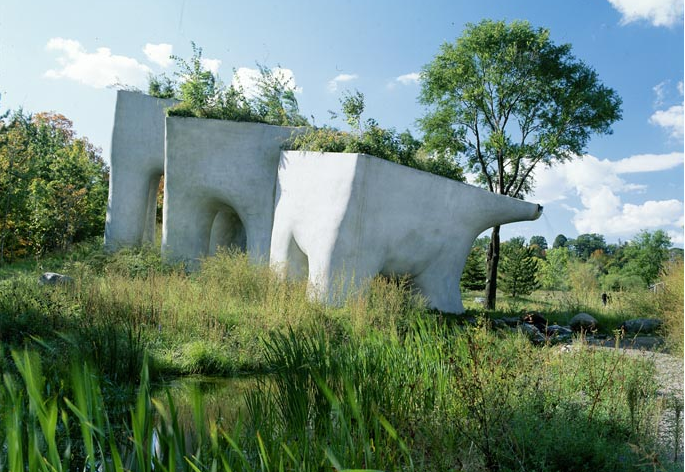Read more from the Spreading Roots conference
Noel responded that each of his projects was created to give the viewer, or user, a feeling. He attempts not to direct it, but to create an experience that will resonate purely, evoking an emotional connection. His art is filled with respect for the earth and its people, striving to create work that honors both.
His answer was one that left me inspired. The materials he uses are things typically found at a construction site; his pallets are our cities. In his quest to evoke emotions, he’s created highly stimulating pieces of green urban infrastructure.

One of his best known is Elevated Wetlands, a part of Taylor Creek Park that can be seen from the Don Valley Parkway in Toronto. These giant polystyrene, tooth or animal shaped containers are functional wetlands that use on-site solar panels to pump water from the Don River through the basins. The water is cleaned by wetland plants (which have the innate biological capacity to remove pollutants from water) anchored in ‘fluff’ (an alternative to soil, made from shredded automobile plastic waste). Completed in 1997 the wetlands continue to cycle water through, with yearly maintenance by Ontario Urban Forest Council (OUFC) volunteers – an interesting twist on recycling.
Another project Noel discussed was the green infrastructure bridge in Windsor, Ontario, part of Harding’s Green Corridor, a master plan for Huron Church Road. The overpass has pine trees growing along the plateau, vines along its sides and naturalized planting areas at each base. The bridge, completed in 2004, lacks some original design features that were cut due to funding constraints: wind turbines and a wetland are examples of features that were to be used by high school students in environmental studies. But even without those features the bridge inspires, offering a bold green statement to both its users on foot and those that drive beneath.

Listening to Noel, I was reminded of the Fort York Pedestrian Bridge in my city and began to re-imagine this local space incorporating a greater scope of environmental systems. My favorite idea is to create a naturalized urban wildlife passage adjacent to the human bridge, attached but quartered off by naturalized fencing. The urban wildlife overpass would connect fragmented habitat areas for small mammals by creating a safe connection over the railroad tracks.
I’m curious to hear what urban spaces YOU might reimagine with a greater environmental design component. Post ideas for locations or treatments below!
PS. One more cool thing Noel revealed; In his bids for public infrastructure projects, he puts aside a portion of the budget for space animation. This money goes to the social infrastructure set in place by organizations for programming once the physical infrastructure is completed.
